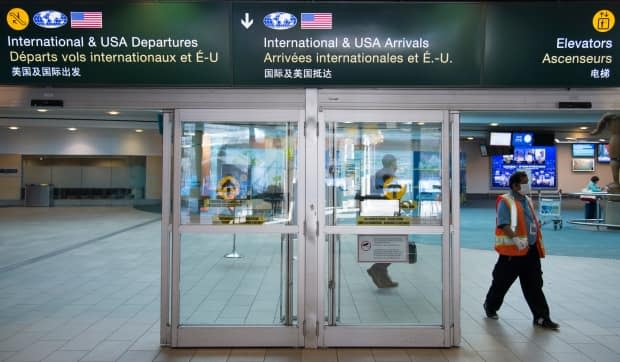Widespread working from home will end at some point, won't it? Maybe not

Trevor Boudreau has already returned to his office at the Vancouver International Airport after a period of working at home — twice, actually.
He first went back in mid-2020, at a time when far-fewer-than-normal flights were coming and going from the country's second-busiest airport and strict rules were in effect on who could be there.
"It was fairly surreal," said Boudreau, manager of government relations for Vancouver Airport Authority, who ended up working at home again by the end of that year.
In 2021, he's gradually made his way back to a world that involves a commute to somewhere outside his home — a journey that millions of working Canadians are likely to take, sooner or later.
Twenty months into the pandemic, more than four million Canadians continue to work from home, despite significant gains in vaccination coverage and efforts to diminish the spread of the coronavirus across the country.
Simply put, the virus is still here and these workers are still not back in the office.
It's a reality that most organizations probably hoped would not be the case this far into the COVID-19 era.

"There continues to be uncertainty amongst employers about what exactly they should do," said Dr. Kumanan Wilson, an Ottawa physician and scientist who's studied pandemics for much of his career.
At this point, Canada's millions of WFH veterans are used to what they're doing and some of them will clearly not want to shift back to the prior setup — and not just because of COVID-19.
"A lot of employees like working at home," said Philip Cross, a senior fellow at the Macdonald-Laurier Institute, an Ottawa-based think-tank.
Working here, working there
Pre-pandemic, Trevor Boudreau's job involved frequent travel and off-site work. He says the work is still getting done now, just as it was then.
"I don't see folks that are still working at home as not being at work," said Boudreau. "We're all still working."

Out in Nova Scotia, Aimée Terrio, who works as an office administrator, has been getting the job done from home, but that's about to change. In December, she'll be making the hour-long commute to downtown Halifax, five days a week.
And she'll be making that trek by herself, as the three others she used to drive in with — including her husband — aren't heading back to the office just yet.
And whether Terrio goes by bus or by car — a decision that's still up in the air — it'll cost more than staying at home.
"That's a big dump [of money]," said Terrio, referring to the costs of a regular commute, which are going up amid inflation, including rising gas prices.
New tech, not a new concept
Despite all the coverage during the pandemic, working from home is not a new trend.
"People have been doing this for years — way back in the '80s and '90s," said Julia Richardson, a professor of HR management at Australia's Curtin University.

The technology involved has improved, though, allowing a lot more people to engage in remote work.
"It's been opened up to a much broader range of industries, a much broader range of individuals," said Richardson, noting people have quickly grasped conferencing tools like Zoom and WebEx. Not only that, they're so comfortable with the technology that they're also using it as part of their social life.
People have also become used to the pandemic-adjusted structure of their days working from home.
For instance, Boudreau said he learned to go for a long walk with his dog before starting his WFH days of "Zoom call after Zoom call after Zoom call."
Terrio said she believes working at home allows for "more balance" between the personal and professional sides of life.
What about employers?
Richardson said that because millions working at home are now accustomed to the change of scenery, many are re-evaluating their working arrangements.
And that has implications for employers.
WATCH | The career impact of WFH:
"I think employers will need to navigate that very, very carefully," Richardson said. "Otherwise, they're going to be facing resignations."
Of course, not all jobs can take place in a remote context, leaving some workers without that option.
"The vast majority of people still have to go into the workplace," said Cross of the Macdonald-Laurier Institute, pointing to the fact the people currently working from home still make up only a fraction of the 19 million people working in Canada.
More generally, front-line workers have been heading into work throughout the pandemic. They've been taking care of business that can't be done from afar.

For those whose job can be done outside a physical workplace, their interests will be weighed against what their employers want.
Cross said employers have their reasons for wanting people back at work, including for supervisory reasons, for team-building and for reinforcing organizational culture. But that doesn't mean that's what employees want.
"When you put the two things together, the employer preference and the employee preference, I see a Pandora's box that has been opened," said Anil Verma, professor emeritus of industrial relations and human resources management at the University of Toronto's Rotman School of Management.
Because "no matter how you cut it," Verma said, some people won't be happy with the result.
Verma said "smart organizations" will look to a dynamic process with clearly set rules that takes into account the needs of the organization and workers' wants.
What lies ahead
Companies and organizations may plan to bring their people back to the workplace on a given timetable, but that doesn't mean they can count on COVID-19 co-operating with them — as seen in cases like Boudreau's, where the return to work has not been a single-step journey.

They'll also be dealing with employees who are concerned about the fact COVID-19 hasn't gone away.
"I think those concerns can be valid," said Wilson, the physician, noting we'll be entering a higher-risk period in the winter "as more and more events start to move indoors because of the cold weather."
He said vaccination is critical to preventing COVID-19 spread, but good ventilation and masking policies in workplaces can help reduce risk on top of that.
"When we do the right thing, we get this under control, we know that," Wilson said. "When we get a little more lax, it seems to come back."

